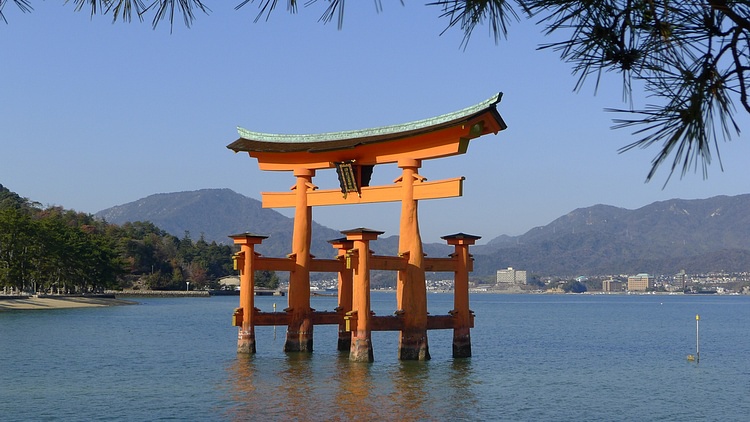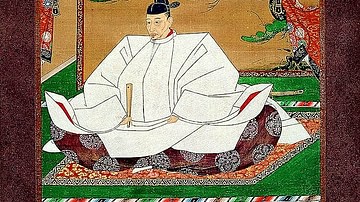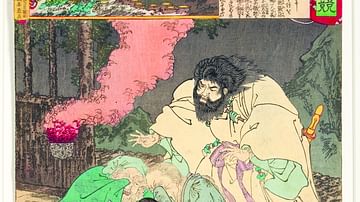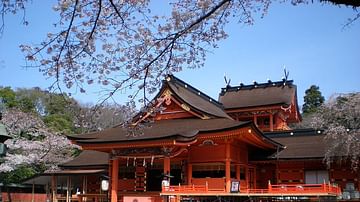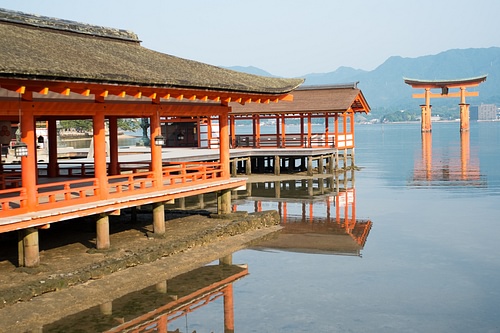
Itsukushima Shrine is a Shinto shrine on the island of the same name, also known as Miyajima, located in Hatsukaichi, Hiroshima Prefecture, Japan. Traditionally founded in the 6th century CE, the present layout of buildings dates to the 12th century CE. With its iconic torii gate, buildings on stilts standing over the sea, and soaring five-story pagoda, the shrine is one of the most easily recognisable of Japan's many ancient shrines. Itsukushima Shrine is an official National Treasure of Japan and has been listed by UNESCO as a World Heritage Site since 1996 CE.
Foundation & Taira no Kiyomori
The Itsukushima Shrine is picturesquely located on an inlet of the island of Miyajima (also known as Itsukushima), hence the shrine's other name of Aki no Miayajima. The island is located in the Hiroshima Bay of the Inland Sea in the Hiroshima Prefecture of southern Japan. The site has been considered sacred since antiquity, and a simple Shinto shrine was likely built there by local fisherman. Then, a more sophisticated complex was built on the island in 593 CE (traditional date but perhaps actually in 811 CE) and credited to one Saeki Kuramoto. It was first dedicated to the three daughters of Susanoo, the Shinto storm god. The trio's full names are Ichikishimahime no mikoto, Tagorihime no mikoto, and Tagitsuhime no mikoto.
In the Kamakura Period (1185-1333 CE), the temple also began to honour Benzaiten (aka Benten), one of the Seven Lucky Gods (Shichifukujin) of Japanese folklore. Benzaiten, a goddess of Hindu-Buddhist origin, is associated with love, fertility, reasoning, literature, music and, of course, good fortune. Here at Itsukushima, she was particularly appealed to for protection by sea travellers and general business success.
All of these gods being worshipped in the same place have given the site its name, Itsukushima, which derives from kami o itsuki matsuru shima or 'island dedicated to the gods.' To maintain the island's spiritual purity, no births, deaths or burials were permitted to take place there, a policy which still, at least in theory, continues today.
The shrine complex is made up of 56 wooden structures which are all built on pillars and so stand above the water. Many of the buildings are connected by walkways and corridors. This unusual positioning over water dates to 1168 CE and is credited to Taira no Kiyomori (1118-1181 CE), a warlord who considered his victories on the battlefield were due to the support of benevolent spirits or kami present on Miyajima. The general and former imperial advisor had already given a celebrated 33-scroll set of illustrated Buddhist sutras or sacred texts, the Heike Nokyo, to the site (see below) before he embarked on his rebuilding project. Itsukushima was then made the head shrine of the powerful Taira clan.
There are several theories as to why Kiyomori decided to build his shrine on stilts. First amongst them is that this would prevent any worshippers ever setting foot on the island itself and so defile it with their presence. A second theory is that the complex is meant to remind of the Buddhist Pure Land belief, which was especially popular in the 12th century CE, that the dead crossed an expanse of water before reaching the next life. A third theory holds that Kiyomori wished to replicate the famous floating palace of the Dragon King in Japanese mythology. Whatever the precise reason for its design, the warlord spared no expense on making it one of the most lavish shrines in Japan which he took great pleasure in showing off to favoured visitors.
Important Structures
Today's visitor to the island is first greeted by one of the most famous and photographed examples of Shinto architecture in Japan, the great red torii gate that stands in the sea 160 metres (524 ft) from the shore. The gate symbolises the frontier of the complex's sacred space. Made from camphor wood from centuries-old trees in order to resist the degrading effect of seawater, the gate was first erected in 1168 CE. The version seen today dates to 1875 CE, and it is possible to reach it on foot at low tide. The gate measures some 16 metres (52 ft) in height and weighs around 60 tons, not including the coins that many people put in the gate's cracks for good luck.
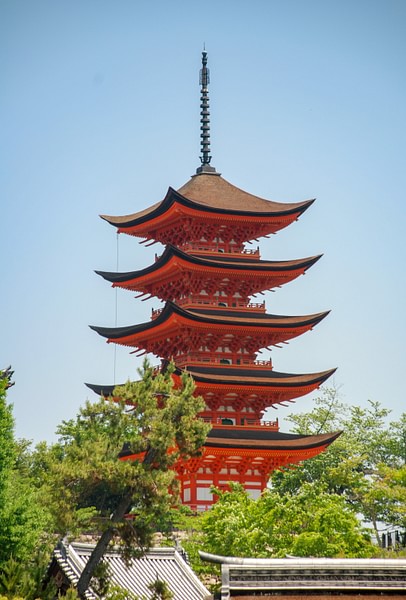
The shrine architecture is a mix of both Buddhist and Shinto styles. The buildings, all oriented in line with the torii gate in front and the sacred Mount Misen behind, are largely in the shinden-zukuri style, the palace architectural style of the Heian period (794-1185 CE) with lots of long wooden corridors connecting spacious rooms with wide views onto the sea. Some of these walkways have gaps to allow the sea through when the tide rises. There are, though, influences from Shinto architecture such as the red columns. A feature of the imperial-style architecture is the shingle roofs made from cypress bark instead of glazed tiles.
The complex is dominated by a five-story Buddhist pagoda which was dedicated to Yakushi, the Buddha of medicine. It was built in 1407 CE. The largest building in the area is the Senjokaku assembly hall, built in the 16th century CE by Toyotomi Hideyoshi (1537-1598 CE), the celebrated general and statesman. The building's name in Japanese signifies that it measures 1,000 mats (the traditional method of floor space measurement in Japan), although it is really a little less at 857 mats, with one mat being about 18 square feet. It was built for congregations of monks to chant their way through Buddhist sutras, but today it is used as a shrine to its founder. The other 15 buildings at the site contain shrines, sub-shrines, and three separate platforms for staging ceremonies, dances, and one for Noh theatre, the only such stage in Japan to be above water. Other structures of interest include a smaller second pagoda, the Soribashi arched bridge and the large front lantern, the Hitsaki.
The Heike Nokyo
As mentioned, Taira no Kiyomori gave a famous collection of Buddhist sutras to the shrine, although this is today housed in the Kyoto Onshi Museum of Art. The official title of the sutras is the Heike nokyo or 'Sutras dedicated by the Heike' (another name for the Taira clan), and it consists of 33 handwritten illuminated paper handscrolls (makimono). They were not just written by anybody either for each one was created by a different individual of the Heike clan, including one by Kiyomori himself who also added a separate roll of prayers. It is the most elaborate of all surviving medieval Lotus Sutra, although it also includes the Amida and Heart sutras. The pages have a wide array of colours and plenty of gold, silver, and mother of pearl embellishments. There are pictures galore, not only illustrations of the texts' religious themes but also scenes of aristocratic life in medieval Japan. Even the case of each scroll is impressive, made from copper and decorated with reliefs of dragons and clouds rendered in gold and silver.
Later History
In 1868 CE the shrine and temple buildings were separated according to their Shinto or Buddhist affiliations, a policy which was carried out at many Japanese sites during the Meiji Restoration. Unfortunately, the shake-up resulted not only in Benzaiten worship being shifted to the nearby Daiganji temple but some of the smaller buildings at Itsukushima were destroyed in the process, although the star pagoda and Main Hall did not suffer any damage. Faithfully restored over the centuries but always maintaining its original 12th-century CE architectural style, the site boasts no fewer than six buildings officially classified as National Treasures of Japan and eleven listed as Important Cultural Properties.
For visitors who see the site at low tide but want to also see it at high tide or vice versa, it is today possible to stay overnight at the shrine and so catch both views. A third view is available at the top of Mount Misen, height 534 metres (1,755 ft), reachable by a pathway or cable car. A good time to visit is near the end of July when there is the Kangensai festival involving gala boats and fishing vessels with lanterns. Finally, one should mention the deer which roam freely around the complex. They are welcomed and protected because it is thought that these animals represent Shinto spirit messengers and remind of Buddha's first sermon in a deer park, nicely combining the two religions like Itsukushima shrine itself.
This content was made possible with generous support from the Great Britain Sasakawa Foundation.
